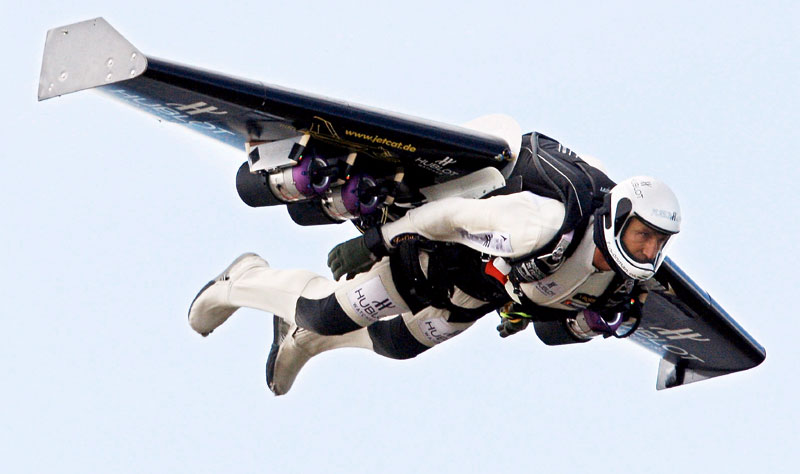Rocketman

Yves Rossy is a pilot. Like most other pilots, he flies things. Unlike every other pilot — ever — the thing he flies is himself. Yves Rossy, pictured above, can fly.
Rossy served in the Swiss Air Force and later became a commercial jet airline pilot, having taken an acute interest in flying at an early age. But commanding enormous jet planes and multi-million dollar fighters was not enough for this particular aviator. He wanted to do something more, something unique, something which could change the world.
In 2006, Rossy began on his mission. He strapped himself into a concoction of his own devising — a jet fuel propelled carbon fiber wing — and took flight. He had just a wing to guide him — no controls, no gauges, no radio to air traffic control. He steered by bending his body in the direction he wished to go, tilting down and up, left and right, much like a bird. He managed to accomplish a feat many have dreamed of for generations — personal human flight.
The wing contains four kerosene powered jet engines capable of reaching over 100,000 revolutions per minute. While flying straight forward, Rossy can hit speeds over over 130 miles per hour and, when descending, can hit speeds of nearly one and a half times that. He needs to maintain a speed of 80 miles per hour to keep flight and lands by deploying a parachute, as seen below after his solo flight above Rio de Janeiro:
While Rossy may come off as a showboating daredevil, that’s hardly the case. He’s a well-worn innovator who has mastered his craft in hopes of blazing a trail for the future. In an interview with Aol Auto’s Translogic (five minute video), Rossy explained that there are limits to what he’s willing to do, out of safety concerns. For example, in order to take flight, Rossy needs to jump out of a plane, helicopter or hot air balloon; it’s safer than taking off from the ground. The reason: in order to deploy his parachute safely, he needs to hit a minimum altitude of 800 meters, which he can get to himself, but it will take a full minute at his engines’ maximum power. That’s too long of a time period, says Rossy, to be without a “Plan B.”
Perhaps one day, Rossy’s innovation will be available for mass consumer use. But don’t expect it to happen anytime soon. Rossy notes that the wing is incredibly difficult to fly, and even the most experienced pilots would have a hard time controlling it in mid-flight. Errors in piloting the wing can lead to horrific results, such as entering into a nearly impossible to control flat spin and, therefore, a violent crash landing.
Bonus fact: In the 1970s or 1980s, Williams International developed the X-Jet, a personal flying machine where the pilot would stand in an open-air pod-like thing and take flight. (The device, which can be seen in flight here, looks like the nickname it earned: the Flying Pulpit.) It never made it into the mainstream. It was loud, expensive, dangerous (hover over something combustible and it’d burn — so much for flying around your house), and inefficient — per Wikipedia, the military deemed the X-Jet to be inferior to helicopters.
From the Archives: Flying Signs: Getting a sign to trail an airplane is harder than you’d think, and requires a rather innovative solution.
Related: “Where’s My Jetpack?: A Guide to the Amazing Science Fiction Future that Never Arrived” by Daniel H. Wilson. 4 stars on 22 reviews.

Leave a comment